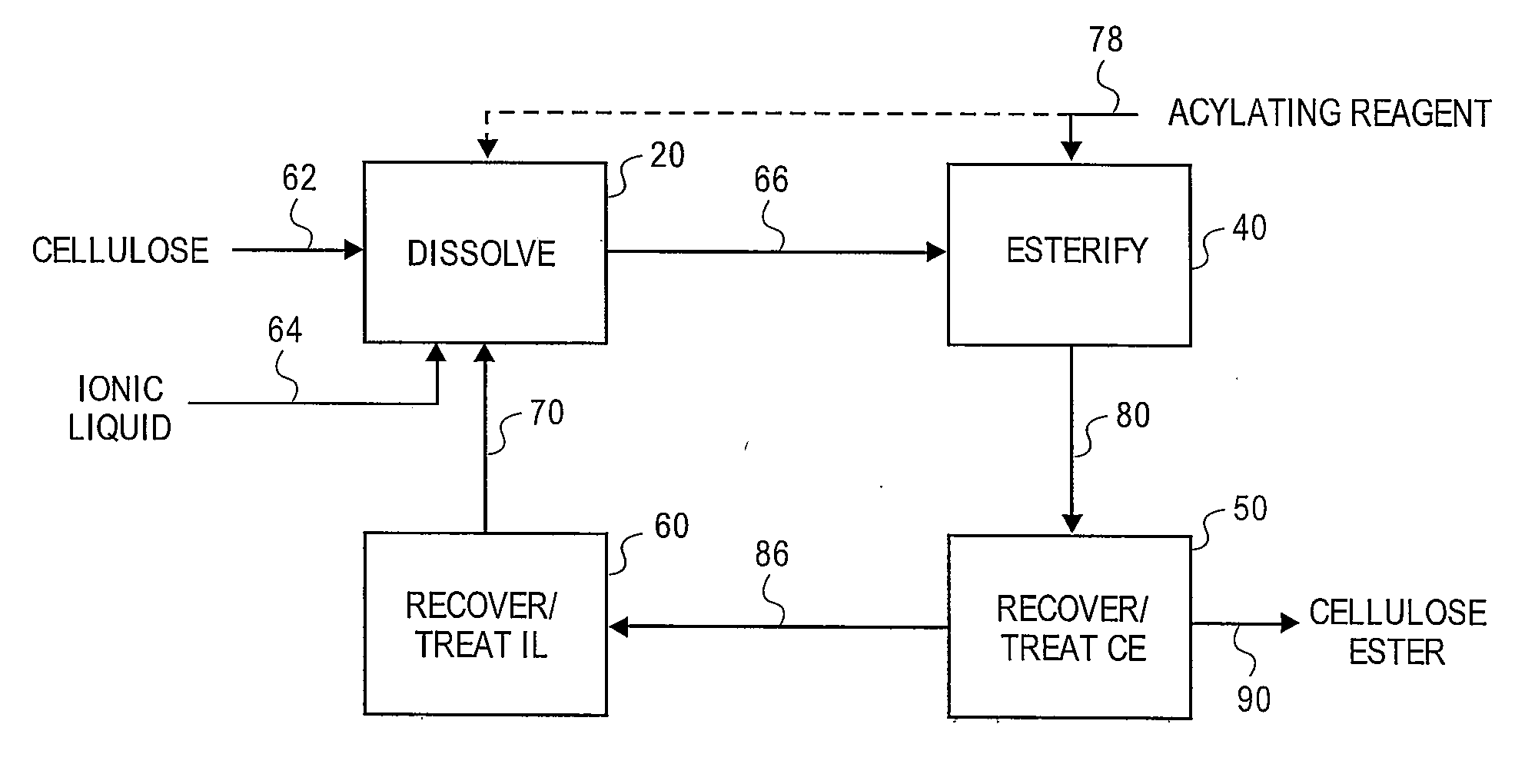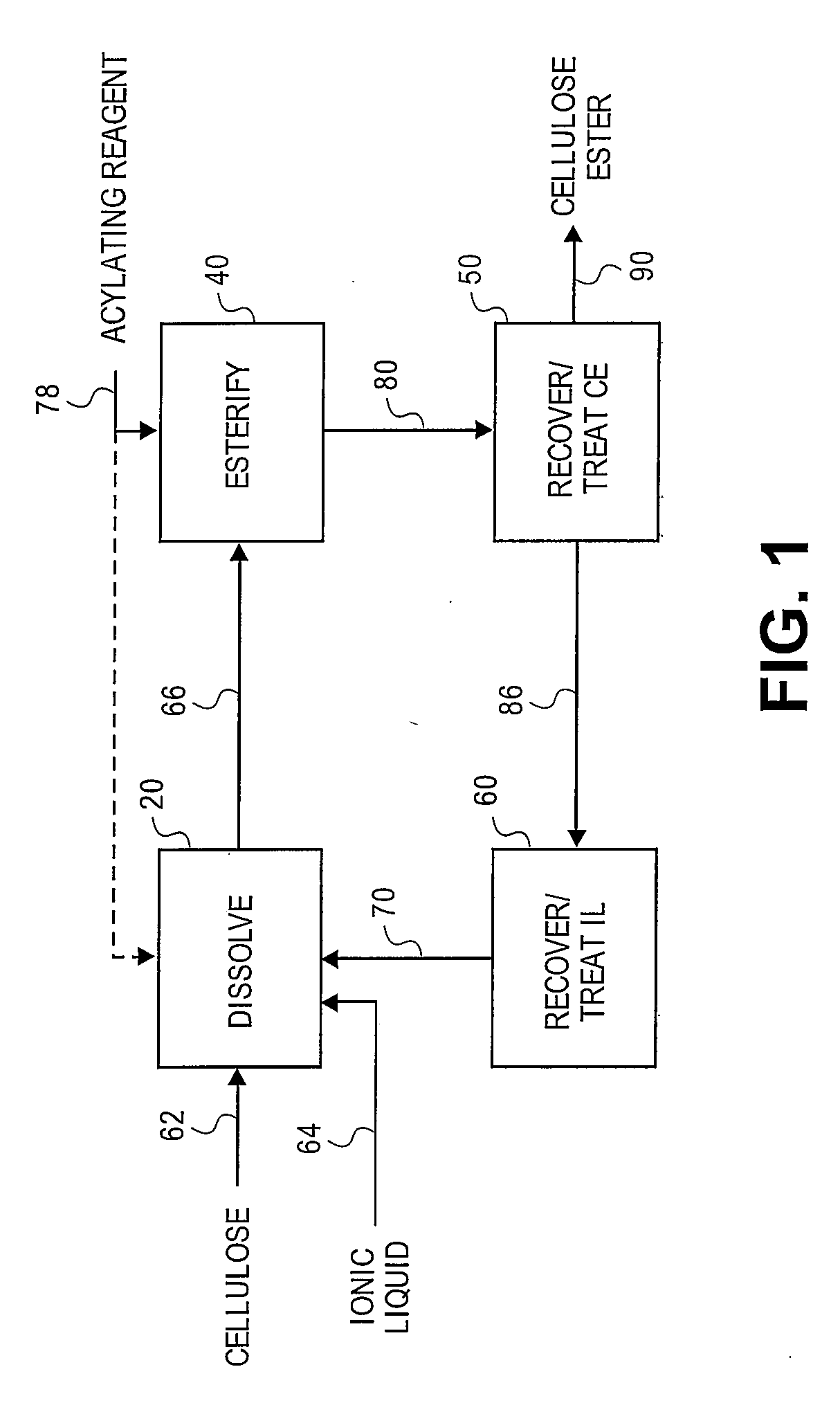Cellulose esters and their production in halogenated ionic liquids
a technology of ionic liquids and esters, which is applied in the direction of esterified saccharide compounds, sugar derivates, organic chemistry, etc., can solve the problems of insufficient methods and apparatuses for reforming and/or recycling ionic liquids, the inability to use ionic liquids as solvents in many processes, and the cost of ionic liquids
- Summary
- Abstract
- Description
- Claims
- Application Information
AI Technical Summary
Problems solved by technology
Method used
Image
Examples
example 1
Preparation of Cellulose Ester
Comparative
[0169]A 3-neck 100 mL round bottom flask, fitted with two double neck adapters for a total of five ports, was equipped for mechanical stirring, and further included an iC10 diamond tipped IR probe (Mettler-Toledo AutoChem, Inc., Columbia, Md., USA) and an N2 / vacuum inlet. To the flask was added 61 g of 1-butyl-3-methylimidazolium chloride (“[BMIm]Cl”), which, prior to addition, had been melted at 90° C. and then stored in a desiccator where the [BMIm]Cl remained a liquid. While stirring rapidly, 3.21 g of previously dried microcrystalline cellulose, having a DP of about 335, was added in small portions over a period of 3 minutes. The slurry was stirred for 5 minutes and then placed under vacuum. After approximately 3 hours and 25 minutes, most of the cellulose had dissolved except for a few small pieces and 1 large piece attached to the probe. After 5.5 hours, the oil bath temperature was increased to 105° C. to speed up dissolution of the re...
example 2
Modification of Cellulose with Water
[0173]A 3-neck 100 mL round bottom flask, fitted with two double neck adapters for a total of five ports, was equipped for mechanical stirring, and further included an iC10 diamond tipped IR probe (Mettler-Toledo AutoChem, Inc., Columbia, Md., USA) and an N2 / vacuum inlet. To the flask was added 64.3 g of [BMIm]Cl, which, prior to addition, had been melted at 90° C. and then stored in a desiccator where the [BMIm]Cl remained a liquid. While stirring rapidly, 3.4 g (5 weight percent) of microcrystalline cellulose, having a DP of about 335, was added at ambient temperature. Approximately 12 minutes after adding the cellulose, the flask was placed in a preheated 80° C. oil bath. After about 17 minutes in the 80° C. oil bath, upon visual inspection all of the cellulose appeared to be dissolved. A vacuum was applied after approximately 22 minutes in the 80° C. oil bath. To insure complete removal of water, 50 minutes after applying vacuum, the oil bath ...
example 3
MSA Secondary Component, No Modification with Water
[0178]3.58 g of cellulose (5 weight percent) was dissolved in 68 g of [BMIm]Cl in a manner similar to Example 2. At a temperature of 80° C., a mixture of 433 mg (0.2 eq.) of methane sulfonic acid (“MSA”) and 6.76 g of Ac2O (3 eq.) was added to the cellulose solution dropwise over a period of 8 minutes. The reaction was sampled throughout the reaction period by removing 6 to 10 g aliquots of the reaction mixture and precipitating in 100 mL of MeOH. The solid from each aliquot was washed twice with 100 mL portions of MeOH then dried at 60° C. at a pressure of 5 mm Hg. The solid samples were snow white. After approximately 2 hours, all of the Ac2O appeared to be consumed, according to the IR spectrum. The experiment was aborted and the remaining sample was processed as above.
[0179]The precipitation and the wash liquids from each aliquot were combined and concentrated in vacuo at 68° C. until the vacuum dropped to 24 mm Hg, which provid...
PUM
| Property | Measurement | Unit |
|---|---|---|
| pKa | aaaaa | aaaaa |
| temperature | aaaaa | aaaaa |
| viscosity | aaaaa | aaaaa |
Abstract
Description
Claims
Application Information
 Login to View More
Login to View More - R&D
- Intellectual Property
- Life Sciences
- Materials
- Tech Scout
- Unparalleled Data Quality
- Higher Quality Content
- 60% Fewer Hallucinations
Browse by: Latest US Patents, China's latest patents, Technical Efficacy Thesaurus, Application Domain, Technology Topic, Popular Technical Reports.
© 2025 PatSnap. All rights reserved.Legal|Privacy policy|Modern Slavery Act Transparency Statement|Sitemap|About US| Contact US: help@patsnap.com



